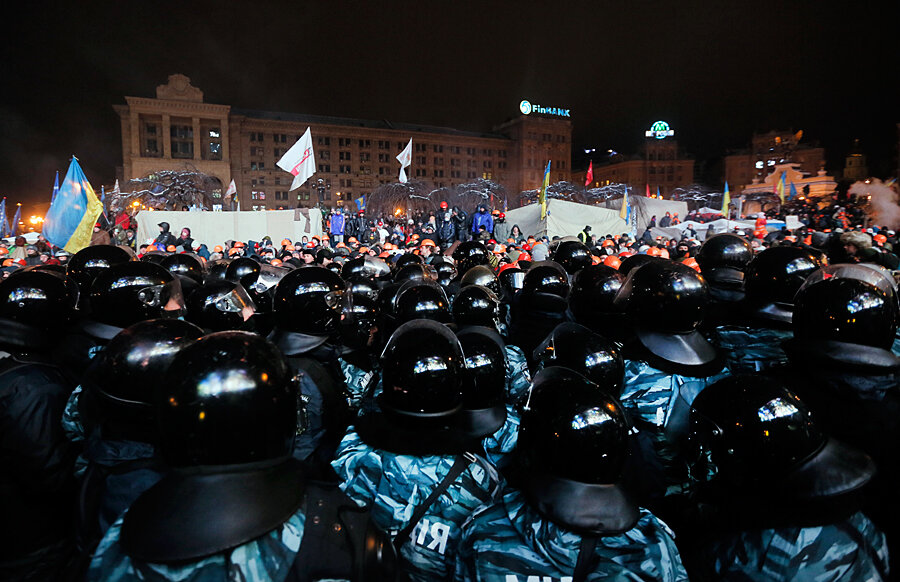Ukraine protests: What's next after riot police pullback?
Loading...
Ukrainian riot police withdrew from the main protester-occupied square in Kiev this morning, after a night of clashes failed to oust demonstrators from their encampment and the government buildings they were occupying.
The New York Times reports that by 11 a.m. local time, most Ukrainian security forces had left Independence Square and its surroundings. While it's unclear why they pulled back, it led to a "festive mood" in sharp contrast with overnight confrontations between police and protesters in the square. Anti-government demonstrators have been occupying the area since late last month, after President Viktor Yanukovych decided not to sign an association agreement with the European Union.
Reuters reports that hundreds of police moved into the area last night, "flood[ing] roads to square and mov[ing] slowly into the main camp, bulldozing tents and barricades... Dozens of demonstrators and police were hurt in scuffles but several officers said they had orders not to use force."
The action appeared to stall as day broke, with temperatures in the snowbound capital stuck at minus 8 degrees Celsius (17 Fahrenheit). Some riot police left to cheers from lines of protesters holding them back. ...
Protesters hailed the police withdrawal on Wednesday.
"I sense a victory. We will hope that our president will understand this and do the right thing and resign," said Andriy Shchyur, a 25-year-old from the Western city of Lviv.
"We are seeing that truth does exist, that it is worth fighting for. It is a small victory, but these small victories will lead to big victories," said protester Serhiy Chorny.
Radio Free Europe reports in its live blog that "30 people have required medical attention and 15 people have required hospitalization, nine police officers and six protesters," as a result of the clashes. Injuries ranged from frostbite to broken bones and head injuries.
Both the EU and the US had top level diplomats on the scene – EU foreign policy chief Catherine Ashton and US Assistant Secretary of State Victoria Nuland are in Kiev – and both roundly condemned the riot police's actions last night. The Financial Times reports that Ms. Ashton said she regretted the use of force “to remove peaceful people from the centre of Kiev,” while US Secretary of State John Kerry expressed Washington's "disgust" with the Ukrainian actions.
“The United States expresses its disgust with the decision of Ukrainian authorities to meet the peaceful protest in Kiev’s Maidan Square with riot police, bulldozers, and batons rather than with respect for democratic rights and human dignity,” he said in a statement.
“As church bells ring tonight amid the smoke in the streets of Kiev, the United States stands with the people of Ukraine. They deserve better.”
Radio Free Europe reports in its live blog of the situation in Kiev that Ms. Nuland, after a two-plus-hour "tough but realistic" meeting with President Yanukovych, said "We have made it absolutely clear to Yanukovych that actions such as those that occurred overnight are unacceptable in a democratic society."
Ukrainian Interior Minister Vitaly Zakharchenko issued a statement calling for calm, notes Reuters. "I want everyone to calm down. There will be no storming of the square. No one will violate your rights to protest peacefully, but do not ignore the rights ... of other citizens."
But while the backlash has spurred the government to reiterate its openness to resume trade talks with the EU, Prime Minister Mykola Azarov warned that Ukraine will need investment to do so. Reuters reports that Mr. Azarov said Ukraine, which faces a potential economic crisis as the political deadlock compounds its financial difficulties, will need 20 billion euros in aid before it can sign a deal with the EU. But he promised that talks with Russian officials, scheduled for Dec. 17, would not include discussion of joining Russia's customs union, a deal which protesters are adamantly opposed to.








